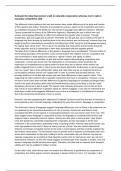Essay
AQA ENG LANG A LEVEL EXAMPLE GENDER ANSWER
- Course
- Institution
An answer to the question... Womens talk is naturally cooperative and mens is naturally competitive. Revision for English Language AQA A Level paper 2. This was marked by my teacher and scored 26/30.
[Show more]



